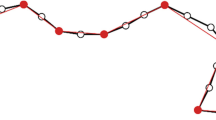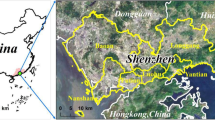Abstract
This paper explores the backpackers’ spatial–temporal behavior (STB) in Beijing using the trajectories obtained from the global positioning system. Many researchers have studied tourist STB from various perspectives and using different data collection methods. Backpackers, who are of growing importance for the global economy and different from the mainstream tourists as a distinguish group, are a kind of postmodern tourists. In this paper we use 1708 trajectories to study the STB of backpackers. At last some conclusions were found from the research: (1) most of the backpackers would travel on Saturday; (2) there are the most trajectories in spring; (3) backpackers usually start their travel in between 8 and 10 o’clock in the morning and end their travel in between 3 and 5 o’clock in the afternoon; (4) most backpackers are keen to travel to the ancient villages. All the above conclusions can help understanding the STB of backpackers, and can be used as the context information for Location-based services.
















Similar content being viewed by others
References
Seddighi, H. R., & Theocharous, A. L. (2002). A model of tourism destination choice: A theoretical and empirical analysis. Tourism Management, 23(5), 475–487.
Beerli, A., & Martin, J. D. (2004). Tourists’ characteristics and the perceived image of tourist destinations: A quantitative analysis—a case study of Lanzarote, Spain. Tourism Management, 25(5), 623–636.
Shailes, A., Senior, M. L., & Andrew, B. P. (2001). Tourists’ travel behaviour in response to congestion: The case of car trips to Cornwall, United Kingdom. Journal of Transport Geography, 9(1), 49–60.
Lau, G., & Mc Kercher, B. (2007). Understanding tourist movement patterns in a destination: A GIS approach. Tourism and Hospitality Research, 7(1), 39–49.
Xia, J., Zeephongsekul, P., & Packer, D. (2011). Spatial and temporal modelling of tourist movements using Semi-Markov processes. Tourism Management, 32(4), 844–851.
Pearce, D. G. (1995). Tourism today: A geographic analysis. Harlow: Longman Scientific & Technical.
Huang Xiao-Ting & Wu Bi-Hu. (2012). Intra-attraction tourist spatial–temporal behaviour patterns. Tourism Geographies: An International Journal of Tourism Space, Place and Environment, 14(4), 625–645.
Ateljevic, I., & Doorne, S. (2003). Unpacking the local: A cultural analysis of tourism entrepreneurship in Murter, Croatia. Tourism Geographies, 5(2), 123–150.
Maoz, D. (2007). Backpackers’ motivations and the role of culture and nationality. Annals of Tourism Research, 34(1), 122–140.
Lew, A., & McKercher, B. (2002). Trip destinations, gateways and itineraries: The example of Hong Kong. Tourism Management, 23(6), 609–621.
Wang, N. (2006). Itineraries and the tourist experience. In C. Minca & T. Oakes (Eds.), Travels in paradox: Remapping tourism (pp. 65–76). Lanham: Rowman & Littlefield.
Ryan, C., & Huimin, G. (2007). Spatial planning, mobilites and culture—Chinese and New Zealand student preferences for Californian travel. International Journal of Tourism Research, 9, 189–203.
Zheng, Y., Zhang, L., Xie, X, & Ma, W.-Y. (2009). Mining interesting locations and travel sequences from GPS trajectories. In WWW (pp. 791–800).
Yuan, J., Zheng, Y., Zhang, C., Xie, W., Xie, X., Sun, G., & Huang, Y. (2010). T-drive: Driving directions based on taxi trajectories. In ACM GIS (pp. 99–108).
Arase, Y., Xie, X., Hara, T., & Nishio, S. (2010). Mining people’s trips from large scale geo-tagged photos. In ACM MM (pp. 133–142).
Antikainen, H., Rusanen, J., Vartiainen, S., Myllyaho, M., Karvonen, J., Oivo, M., et al. (2006). Location-based services as a tool for developing tourism in marginal regions. Nordia Geographical Publications, 35(2), 39–50.
Fritsch, L., & Scherner, T. (2005). A multilaterally secure, privacy-friendly location-based service for disaster management and civil protection. In Networking-ICN, 2005, 1130–1137.
Hall, C. M., & Page, S. (2006). The geography of tourism and recreation. Environment place and space: Routledge.
Buhalis, D., & Licata, M. C. (2002). The future eTourism intermediaries. Tourism Management, 23(3), 207–220.
Frihida, A., Marceau, D. J., & Thériault, M. (2004). Development of a temporal extension to query travel behaviour time paths using an object-oriented GIS. Geo-Informatica, 8(3), 211–235.
Lew, A., & McKercher, B. (2006). Modeling tourist movements. A local destination analysis. Annals of Tourism Research, 33(2), 403–423.
Wang, D., & Cheng, T. (2001). A spatio-temporal data model for activity based transport demand modelling. Geographical Information Scienece, 15(6), 261-581.
Ahas, R., & Mark, Ü. (2005). Location based services—new challenges for planning and public administration? Futures, 37(6), 547–561.
Fennell, D. (1996). A tourist space-time budget in the Shetland Islands. Annals of Tourism Research, 23, 811–829.
Pearce, D. (1987). Tourism today: A geographical analysis. Harlow: Longman. 1988 Tourist Time-budgets. Annals of Tourism Research 15:106–121. 1989 Tourist Development (second ed.). Harlow: Longman.
Debbage, K. (1991). Spatial behavior in a Bahamian resort. Annals of Tourism Research, 18, 251–268.
Ahas, R., Aasa, A., Roose, A., Mark, Ü., & Silm, S. (2008). Evaluating passive mobile positioning data for tourism surveys: An Estonian case study. Tourism Management, 29, 469–486.
Huang, Q., Xia, L., & Wu, D. (2014). An enhanced hybrid LBS and its prototype for supporting backpackers in Beijing. Wireless Personal Communications, 77, 433–448.
Haywood, K. M., & Muller, T. E. (1988). The urban tourist experience: Evaluation satisfaction. Hospitality Education and Research Journal, 18(2), 453–459.
Beeho, A. J., & Prentice, R. C. (1995). Evaluating the experiences and benefits gained by tourists visiting a socio-industrial heritage museum: An application of ASEB grid analysis to Blists Hill Open-Air Museum, The Ironbridge Gorge Museum, United Kingdom. Museum Management and Curatorship, 14(3), 229–251.
Graefe, A. R., & Vaske, J. J. (1987). A framework for managing quality in the tourist experience. Annals of Tourism Research, 14, 390–404.
Kwan, M. P. (2000). Interactive geovisualization of activity-travel patterns using three-dimensional geographical information systems: Methodological exploration with a large data set. Transportation Research C, 8, 185–203.
The instructions of ArcGIS10.0.
Acknowledgments
This study is supported by the funding from Guangdong Province Major Special Project of Science & Technology (2015B010104003).
Author information
Authors and Affiliations
Corresponding author
Rights and permissions
About this article
Cite this article
Huang, Q., Xia, L. Inspection of Spatial–Temporal Behavior of Backpackers in Beijing Based on Trajectory. Wireless Pers Commun 87, 1337–1356 (2016). https://doi.org/10.1007/s11277-015-3056-0
Published:
Issue Date:
DOI: https://doi.org/10.1007/s11277-015-3056-0




